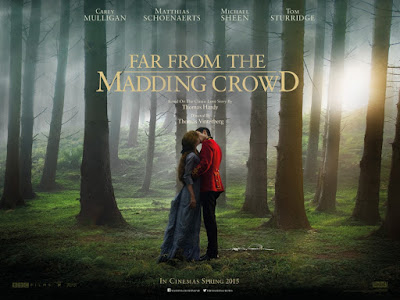A summary of my results:
How do you think context is
best established in a Period Drama?
It is best to establish context of
the piece through accurate overall Mise-En-Scene and Costume. Setting is of
course still important as 37.5% of my audience chose this. I find it
interesting that 0% of the responses chose dialogue as a key factor of
establishing a time zone. This response I will have to take with a pinch of
salt as the Period Drama as a genre needs dialogue, but I will take into
account that I should perhaps focus on other elements more than dialogue.
What type of camera shots
would you associate most with the Period Drama?
My response shows, relatively conclusively, that the Two-shot is most
important for the viewer when watching a successful Period Drama. Interestingly,
Establishing shots and Long shots were also regarded as important (which they
are). Therefore, I will focus on these two types of shots when composing my
piece.
What kind of setting would you
prefer in a Period Drama?
As I made this question have a written response, I have allowed my
viewer more of a say in terms of what they want. Many responses refer to a manor
house or an older house. Due to budget limitations, I may not be able to find
such a location. However, I found these responses insightful:
"One main setting which is symbolic of the theme being portrayed"
"A Wood or Forest"
"An extravagant garden"
If I was to combine these responses, I’d come to the conclusion that if
I chose an outdoors setting that is applicable to my time frame, alongside an
appropriate narrative, this kind of setting could become symbolic to the mise-en-scene
of my film.
Select a theme you feel
is most important in a short film:
Interestingly, ‘Class Divisions’ as a theme received a very high vote with Romance appearing to
be the second most popular. In aspect of the pieces I have studied, Class Division
plays a big part of the genres definition alongside an important romantic
element. Therefore, my film will try to use nuances of both themes within my
script.
Would you prefer characters to
speak with regional accents?
Before discussing the results to this question, I should probably explain
why I’ve asked this question. In the short films ‘Lacey’ and ‘Mesmerize Me’, I
found that the two protagonists were most relatable and likable due to their
thick character accents that gave the script more authenticity and depth of
character. So I asked this question to see if an audience also had the same
feelings in response to regional accents and with ‘Yes’ receiving 87.5% of the
vote, I think it is obvious that this is very much the case.
Therefore, when writing my script and preparing my actors I should make
this a defining feature.
What kind of music would you
expect to be used in a Period Drama?
Out of all of my questions, I found that this question received the most
varied feedback in terms of numbers. Equally, both a piano-based score and no
score at all (which allows a focus on dialogue) were voted for. Consequently, I
will use a mixture of both techniques (like many conventional Period Drama’s) that
uses a piano soundtrack that cuts off during a vital moments of conversation.
This should be done subtly so that the viewer is not too-aware of this
transition of the audible.
Do you think a romantic
implication is need in a Period Drama?
They voted ‘Yes’. This means that when composing my script and line of
narrative, I’m going to ensure that there will be a romantic implication.
How would you prefer a short
film to end?
Interestingly, the responses, almost unanimously, state a preference for
a ‘definite ending’ with a ‘resolution’. Considering that my film will only be
around 5 minutes, a certain ending would
perhaps prove challenging. However, I do agree with the notion that a Period
Drama short film should end on a ‘neat and tidy’ basis where the audience feels
that issues have been resolved.
What is your overall aim when
watching a Period Drama?
I asked this question mainly due to curiosity but also because the
responses will give an important insight into what the consumer actually wants.
Many viewers refer to escaping or learning about time zones/periods whilst
other viewers refer to connecting with characters or to be nosey. In a sense,
this is exactly what I want. I want viewers to be transported to a different
time and to, essentially, get them to emotionally invest into my characters. This,
of course, doesn’t go without its challenges but I am hoping that with a good
script and production – I can achieve this aim successfully.
































